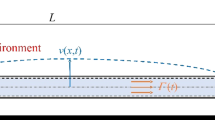Absyract
Based on the immersed boundary method, a fast simulation for solving unsteady, incompressible, viscous flow associated with the oscillating cascade is established on a quasi-three-dimensional coordinate system. The numerical method is applied to the simulation of the flow passing an oscillating circular cylinder which is forced to move in X direction under prescribed motions in water at rest at low Keulegan-Carpenter numbers. Then vortex-induced vibration of a cylinder with two degrees of freedom which oscillates in in-line direction and transverse direction is simulated using this method. The results are in good agreement with the previous research. Then the method is extended to the oscillating cascade simulation of making various comparisons. It is found that the IBPA (inter blade phase angle) will change as the time goes on, because of the non-uniformity of the flow in the circumferential direction, until the oscillating cascade goes to a stable situation. The reduced velocity and the number of blades are chosen to investigate the effects of them on IBPA. The results indicate that both the reduced velocity and the number of blades are the main factors which influence IBPA. It is worth noting that the coupling process is not necessary to generate any body-fitting grids, which makes it much faster in computational process for such a complicated fluid-structure interaction problem.
Similar content being viewed by others
References
Whitehead, D. S., “The Vibration of Cascade Blades Treated by Actuator Disk Methods,” Proceedings of I. Mech. E., vol.173, 1959, pp.555–557.
Yang, T. Y., Guruswamy G P, Stritz A G. “Flutter Analysis of a NACA 64A006 Airfoil in Small Disturbance Transonic Flow,” AIAA Journal of Aircraft, vol.17, 1980, pp.225–232.
Yang, T. Y., Guruswamy, G. P., Stritz, A. G., “Application of Transonic Codes to Flutter Analysis of Conventional and Supercritical Airfoil,” AIAA Journal of Aircraft, vol.19, 1982, pp.211–220.
Carta, F. O., “Coupled Blade-disc-shroud Flutter Instabilities in Turbojet Rotors,” ASME Journal of Engineering for Power, vol.89, 1967, pp.419–426.
Gottfried, D. A., “Simulation of fluid-structure interaction in turbomachinery,” Purdue University, West Lafayette, IN, Doctor of Philosophy thesis, 2000.5
Lane, F., “System mode shapes in the flutter of compressor blade rows,” Journal of the Aeronautical Sciences, vol.23, 1956, pp.54–66.
Srinivasan, A. V., “Flutter and resonant vibration characteristics of engine blades,” Journal of Engineering for Gas Turbines and Power. Vol.119, 1997, pp.742–751.
Cinnella, P., de Palma P., Pascazio G. et al. A numerical method for turbomachinery aeroelasticity,” ASME Journal of Turbomachinery, vol.126, 2004, pp.310–316.
Sadeghi, M, Liu F., “Computation of mistuning effects on cascade flutter,” AIAA Journal, vol.39(1), 2001, pp.22–28.
Yang, X. D, Tao, D. P, Zhou, S., “Turbomachinery aeroelasticity for a discussion of the basic assumptions,” Science in China Series A, vol.2, 1991, pp.192–199.
Peskin, C. S., “Numerical analysis of blood flow in the heart,” Journal of Computational Physics, vol.25(3), 1977, pp.220–252.
Zhong, G. H., Sun, X. F., “A Simulation strategy for an oscillating cascade in the turbomachinery using immersed boundary method,” AIAA Journal of Propulsion and Power, vol.25(2), 2009, pp.312–321.
Chima, R. V., “Explicit Multi-grid Algorithm for Quasi-Three-Dimensional Viscous Flows in Turbomachinery,” Journal of Propulsion and Power, vol. 3(5), 1987, pp.397–405.
Goldstein, D., Handler, R., Sirovich, L., “Modeling a no-slip flow with an external force field,” Journal of Computational Physics, vol.105(2), 1993, pp.354–366.
Armfield, S, Street, R., “The fractional-step method for the Navier-Stokes equations on staggered grids: the accuracy of three variations,” Journal of Computational Physics, vol.153, 1999, pp.660–665.
Dutsch, H., Durst, F., Becker, S., and Lienhart, H., “Low-Reynolds-number flow around an oscillating circular cylinder at low Keulegan-Carpenter numbers,” Journal of Fluid Mechanics, vol.360, 1998. pp.249–279.
Singh, S. P, Mittal, S., “Vortex-induced oscillations at low Reynolds numbers: Hysteresis and vortex-shedding modes,” Journal of Fluid and Structures, vol.20, 2005, pp.1085–1104.
Zhong, G. H., Liang A., Sun, X. F, “Numerical simulations of fluid-structure interaction Using immersed boundary method,” XVIII international Symposium on Air Breathing Engines, Beijing China. ISABE 2007-1230.
Piperno, S, “Explicit/implicit Fluid/structure Staggered Procedures with a Structural Predictor and Fluid Subcycling for 2D Inviscid Aeroelastic Simulations,” International Journal for Numerical Methods in Fluids, vol.25, 1997, pp.1207–1226.
Author information
Authors and Affiliations
Rights and permissions
About this article
Cite this article
Hu, G., Du, L., Zhong, G. et al. A numerical modeling of the vortex-induced vibration of cascade in turbomachinery using immersed boundary method. J. Therm. Sci. 20, 229–237 (2011). https://doi.org/10.1007/s11630-011-0463-8
Received:
Published:
Issue Date:
DOI: https://doi.org/10.1007/s11630-011-0463-8




